Italy is a very popular destination for expats from all over the world, and for good reason. Its climate, its colors, cultural riches, and the very essence of Mediterranean living are the prime reasons so many expats have already packed their bags and moved to the country.
This comprehensive guide on living in Italy as an expat aims to provide essential information and insights into various aspects of moving to and settling in Italy, including visas and residency, healthcare, housing, cost of living, cultural experiences, and more.
In this guide:
- The legalities of moving to Italy: visas and residency options for non-EU nationals.
- The cost of living: daily expenses, rentals, and real estate.
- Infrastructure: travel connections, public transport, internet.
- Italy as a retirement destination.
- Healthcare and education.
- Taxes and bank accounts.
- Where to live in Italy – an overview of the most popular expat locations.
Secure Peace of Mind with Best-Value International Health Coverage
International Citizens Insurance provide free, no-obligation quotes from the leading international health insurance providers with plans tailored to meet your needs. Trusted by thousands of expats worldwide.
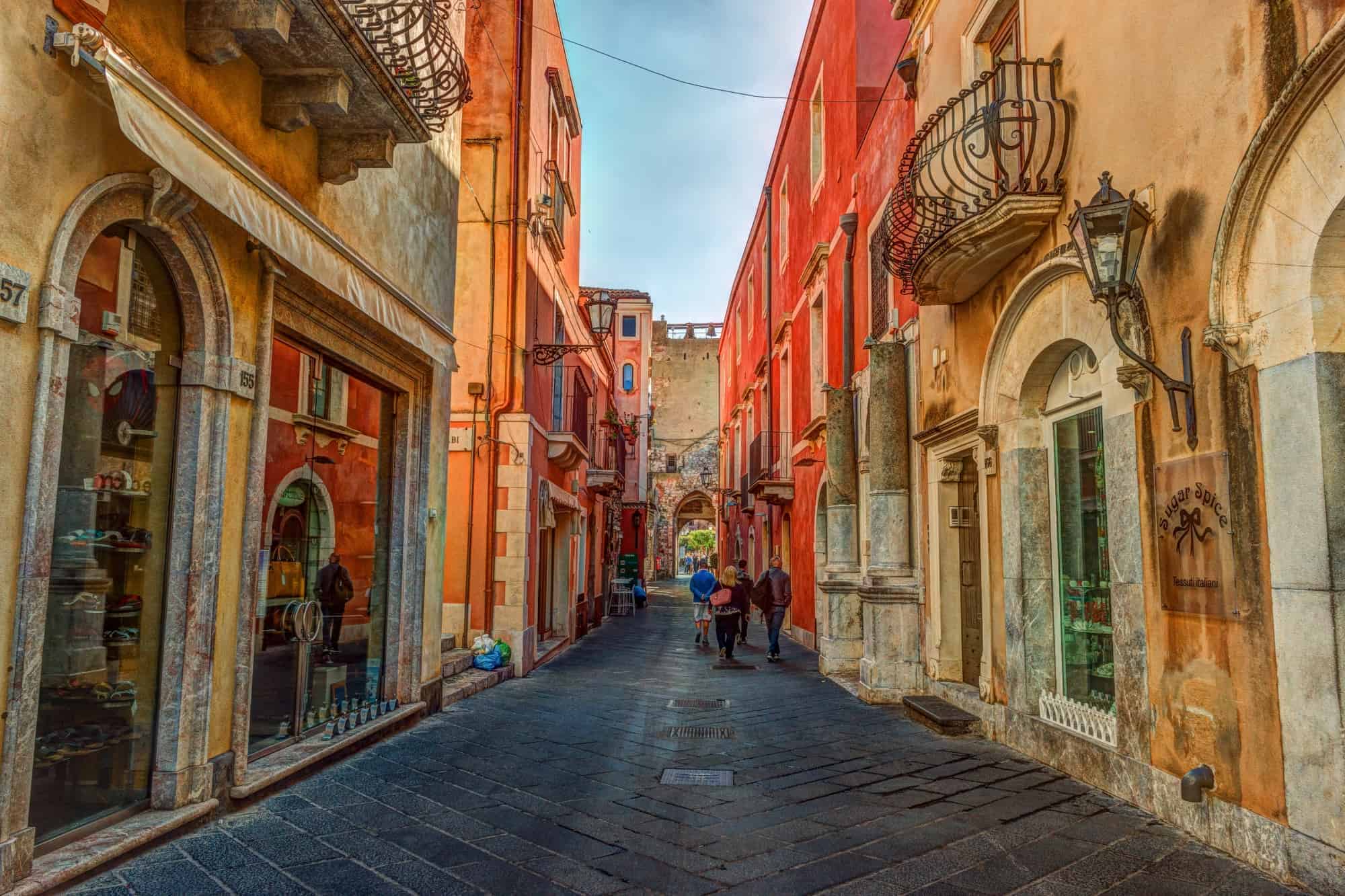
Living in Italy: highlights
- Diverse climate and weather: Italy boasts diverse climate zones, ranging from the Mediterranean on the coast to alpine in the north, making it a unique destination for all types of weather preferences.
- Good quality healthcare: Italy's regional-based nationalized healthcare service, the Servizio Sanitario Nazionale, is of good quality and is often ranked in the top 10 healthcare services in the world.
- Culture: rich history, art, cuisine, and the warm, welcoming nature of its people.
- Affordable property can be found: You don’t need to be an Italian resident to buy property in Italy. There are places where property is pretty affordable, especially in the south.
- Favorable tax regime for foreign retirees: expats with passive incomes moving their residence to Southern Italy can pay a 7% flat tax on all income sourced outside Italy.
Residency in Italy for non-EU citizens
If you are a non-EU national and want to stay in Italy for longer than 90 days, you need to apply for a long-term visa.
The elective residency visa
The elective residency visa – also known as the retirement visa – is perhaps the most relevant for self-sufficient people. To be eligible for this kind of visa, you must elect not to work in Italy and have sufficient finances to support yourself.
The requirements include:
- A minimum of €31,000 a year for a single person or €38,000 a year for a married couple. This amount increases by 20% for every dependent.
- Proof of address, which can either be an owned or leased property.
- Proof of health insurance, which must cover €30,000 and all medical expenses. Once a resident, you can use public healthcare.
- Valid passport.
- Civil status documents (marriage and birth certificates).
- Proof of a clean criminal record from your home country.
You have to apply for an Italian retirement visa at the Italian consulate in your home country before you move to Italy. Once in Italy, you can then apply for a temporary residence permit after eight days.
If your plan is to take “halfway retirement”, such as opening a B&B or similar, you’ll need to apply for an Italian working visa – specifically a self-employed visa.
The application process is fairly similar, but you need something called a Nulla Osta, which is authorization to perform self-employed work in the country.
Regardless of which visa you acquire, once you’re a permanent resident in Italy, you need a digital biometric ID. You can apply for one at your local police station, and it’s a legal requirement to do so.
There are various fees involved in the Italian residency process, along with quite a bit of paperwork.
However, there are various Italian relocation services designed to make the process much easier for expats. They assist with paperwork, applications, translations, and much more. While an extra cost, it certainly justifies itself due to how much stress it’ll save.
Italian investment visa
Unlike other European countries, Italy doesn’t have a Golden Visa program. However, in 2017, it launched the investor visa, which covers similar grounds to other golden visa programs.
You have several options for how you can invest your money:
- Government bonds issued by the country
- An Italian-operated and incorporated company
- Startups based in Italy
- A charitable donation in fields of culture, research, education, culture, or natural heritage
The minimum donation is €500,000, but the amount you invest depends on where you plan to invest the money. For example, you need to invest €2 million in government bonds, donate €1 million to charity, or invest €500,000 in a business or startup.
You also need to have evidence of an annual income of €100,000, but this can come from various sources, including other investments, stock, annuities, and so on.
If you make a substantial investment in Italian property, the annual income requirement drops to €35,000. While there isn’t an official figure for this “significant investment”, consider it to be somewhere around €500,000.
Unlike other visa programs, you need to go directly through the Italian Ministry of Economic Development. You begin by submitting an application on their website, and, providing this is successful, you then have six months to apply for a visa at an Italian embassy.
Once in the country, you’ll need to visit a local police station to get the investor residency permit. This is valid for two years, and to renew it, you need to maintain your investment (rather than making another).
An Italian investment visa is definitely one way of speeding up the application process. Importantly, too, it offers a much greater chance of successful application and eventually leads to permanent residency.
Citizenship by descent
To claim Italian citizenship by descent, you need to prove that your Italian-born ancestor was an Italian citizen when you were born.
Before August 15, 1992, getting another citizenship automatically meant giving up Italian citizenship. However, children born in countries like the United States gained dual citizenship due to their birthplace.
If your ancestor's Italian citizenship is confirmed, you can pass it on to future generations.
Italy follows the Strasbourg convention, which affects citizenship in some cases, and the key date for Italian citizenship claims is March 17, 1861, when Italy was established as a nation.
Children born to Italian citizens are typically Italian citizens, but there are some conditions, like the Italian parent not naturalizing in another country before August 15, 1992, for children born before that date.
The cost of living in Italy
You might find that the cost of living in Italy isn't that lower than in your home country, especially if you are planning to move to the northern regions. However, property prices and rent are cheaper than in the UK, USA, or Northern Europe. Overall, this balances out in your favor.
Here's how Italy's cost of living compares to some Northern European and North American countries:

The cost of living will vary massively depending on where you decide to settle down. For example, larger, busier cities like Rome and Milan will have a much higher cost of living.
Housing
Housing will be your most significant expense, particularly if you rent. Here's a table of the most popular areas in Italy with an average rent and property price:
| Region | Average Rent Per Sq Meter | Property Price Per Sq Meter |
|---|---|---|
| Lombardy | €16.56 | € 2,100-2,300 |
| Tuscany | €14.62 | € 2,500-2,700 |
| Veneto | €11.15 | €1,700-1,900 |
| Campania | €9.6 | €1,700-1,900 |
| Emilia-Romagna | €13.09 | €1,900-2,100 |
| Piedmont | €8.75 | €1,300-1,500 |
| Lazio | €14.13 | €2,300-2,500 |
| Sardinia | €14.15 | €2,300-2,500 |
| Sicily | €8.05 | €1,100-1,300 |
| Liguria | €10.98 | €2,500-2,700 |
| Calabria | €8.88 | Below €1,100 |
| Puglia | €8.76 | €1,300-1,500 |
Data source: immobiliare.it
Tip: Finding short term non-holidays rentals are quite challenging in Italy. A short-term lease will usually last for around 18 months, and long-term leases last a minimum of three years, if not more. Being stuck in one area can make property hunting a challenge.
Other expenses
Essential monthly expenses are higher in the north of the country than in the south of Italy:
In the North of Italy:
- Groceries: On average, you can expect to spend around €250-€350 per month on groceries for a single person.
- Utilities: The monthly cost of utilities such as electricity, water, and gas can range from €150 to €200, depending on the size of your apartment and your usage.
- Internet: Basic internet plans in the north of Italy usually cost around €30-€40 per month.
- Dining out: Eating out at restaurants in the north of Italy can be quite expensive. A meal at a mid-range restaurant can cost between €30 and €45 per person.
In the South of Italy:
- Groceries: Groceries in the south of Italy tend to be more affordable compared to the north. You can expect to spend around €190-€270 per month on groceries for a single person.
- Utilities: Similar to the north, the monthly cost of utilities in the south can range from €150 to €200, depending on your consumption.
- Internet: Basic internet plans in southern Italy usually cost around €25-€35 per month.
- Dining out: Eating out at restaurants in the south of Italy is generally more cost-effective compared to the north. A meal at a mid-range restaurant can cost between €15 and €25 per person.
Please note that these are rough estimates, and actual expenses may vary depending on individual lifestyle and location within Italy.
Italy as a retirement destination
According to the Expatra Global Retirement Index, Italy consistently appears in the top ten best countries to retire worldwide.
The index is based on the Expatra Global Retirement Survey that asks international retirees to rate their retirement destination’s infrastructure, climate, ease of settling down, value for money, friendliness, and other aspects of life in Spain.
Here's how Italy scores:
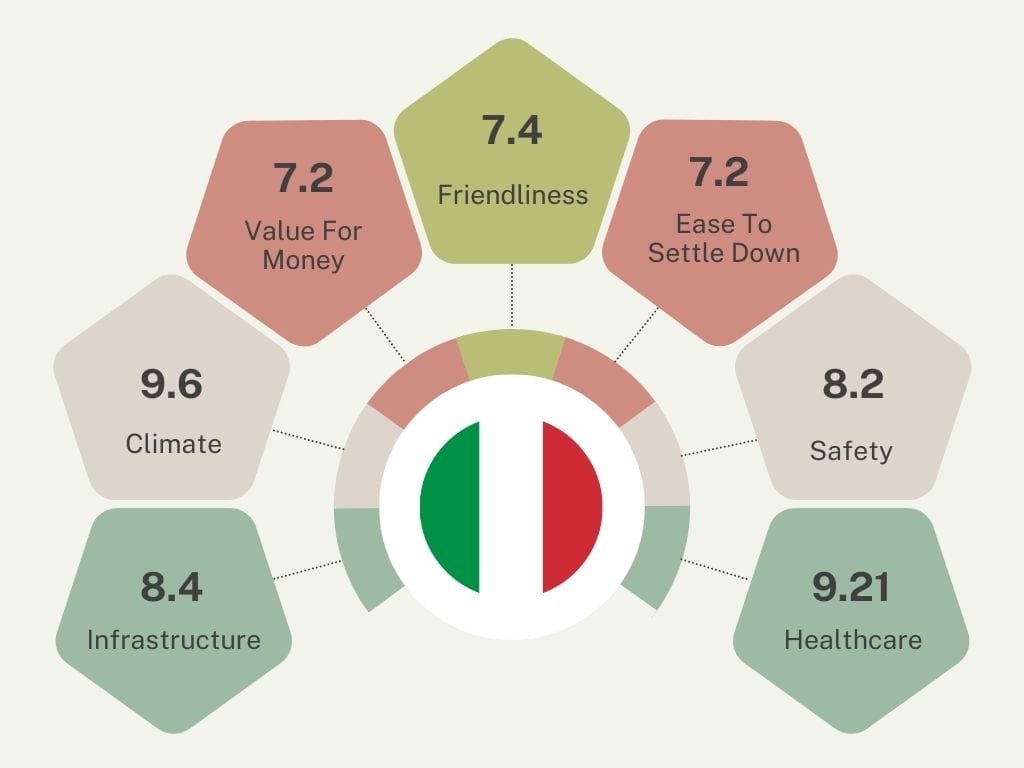
Italy's unique lifestyle and cultural appeal draw many expat retirees to the country.
From picturesque countryside villages to iconic cities like Rome, Florence, and Venice, there is no shortage of breathtaking scenery to explore.
The Mediterranean climate, delicious cuisine, and renowned wines add to the allure. Plus, Italy has good quality healthcare.
How much money do you need to retire to Italy?
The Italian elective residency visa (retirement visa) requires you to have an annual income of between €31,000 and €38,000. This works out as a minimum of €2,500 a month. This figure doesn’t just cover pension income; it includes other financial sources, such as investments and annuities.
It’s worth noting that you’ll be able to do quite a lot with this kind of income, especially in the south of Italy.
Italian flat tax for expat retirees
Italy offers a great tax discount for expat retirees: if you retire to Italy, you will pay a seven percent tax on your pension income for the first ten years of residency.
However, after your ten-year tax-free residency expires, you are liable for income tax at Italian rates ranging from 23 percent on income up to €15,000 (£13,500) to 43 percent on income over €75,000.
- Italian Taxes & Tax Advantages For Expats Explained - all about the flat tax for retirees, the non-dom tax, expat workers tax relief in Italy, Italian income tax rates, and property taxes
The cheapest place to retire in Italy
Currently, the cheapest place to retire in Italy is either Palermo in Sicily or Bari on the Adriatic coast. The cost of living ranges from €1,100 to €1,300.
These towns have little interest for tourists, making them particularly quiet. That said, they still offer plenty of heritage and culture but a more Italian, localized version.
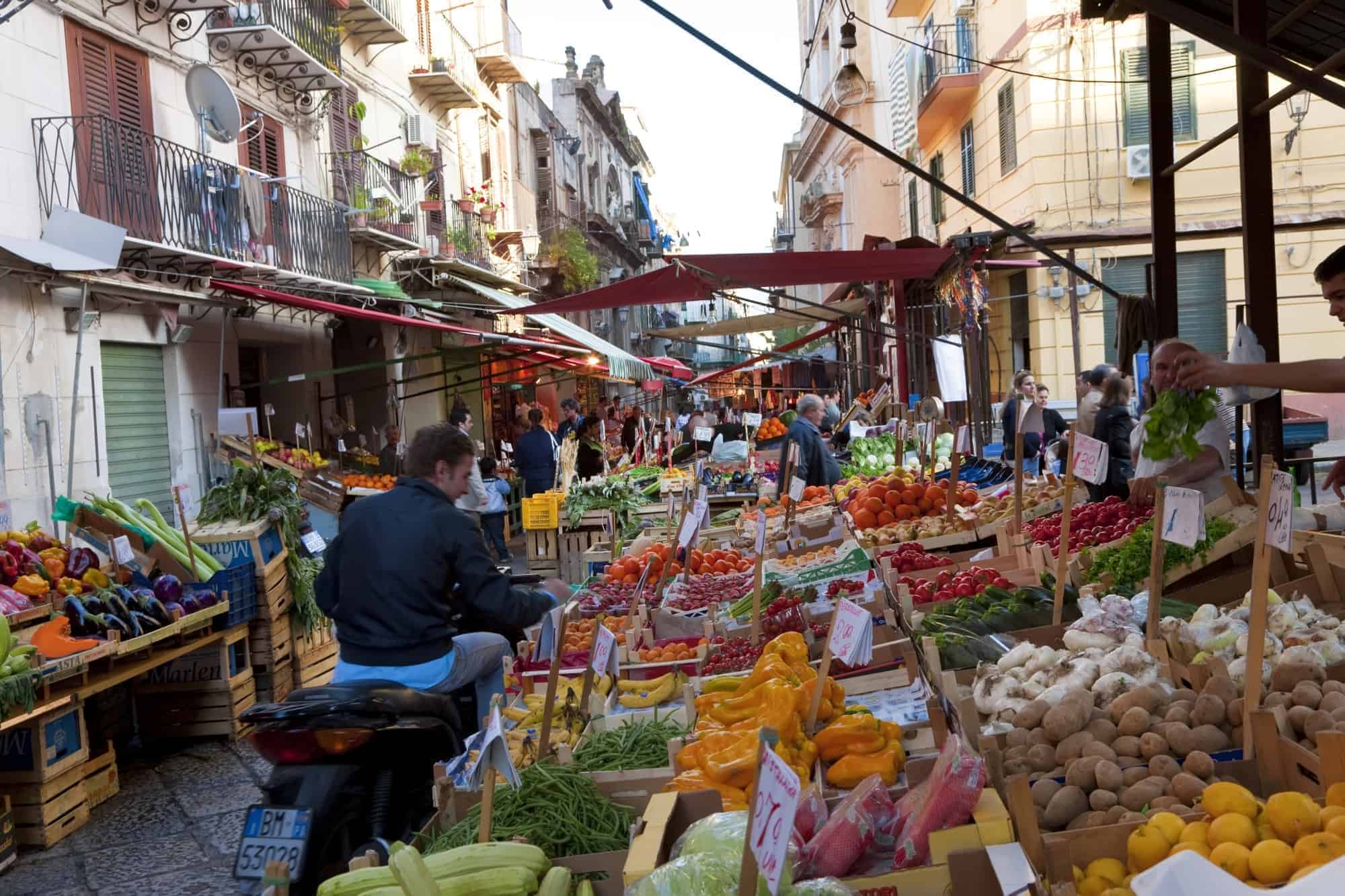
Bari is a medieval town that, until recently, has flown under the international radar. Increasing numbers of cruise ships have been docking there in recent years, which has led to an overhaul in amenities.
However, property prices and cost of living are still considerably lower than elsewhere. You can easily pick up a nice apartment for €70,000 and an exquisite villa and trulli for less than €500,000.
That said, a renovation project will go for next to nothing if you’re willing to put in a bit of work.
The same is true for Palermo in Sicily. You can find a house in the city center for as little as €60,000 or an out-of-town villa for €90,000.
Sicily is a beautiful island with a warm Mediterranean climate. Realistically, many of its towns have low property prices, but Palermo has the benefit of being a bustling city with plenty of activities. Expats moving to Sicily love the island for its unique lifestyle, climate, and culture.
Healthcare in Italy
Italy’s national healthcare service offers high-standard services.
You only have access to it once you become a resident, and you’ll need to register with a local doctor to obtain your health card and number.
If you’re not working or paying social security contributions, you might have to pay an annual voluntary fee for access.
Public health insurance in Italy
The SSN (Servizio Sanitario Nazionale - National Health Service) is Italy’s public health insurance. Almost everyone, even non-EU expats who move for work, is entitled to mandatory free registration. This will give you access to general doctors and specialists.
However, in some rare cases, such as living in Italy with an elective residency permit, you will have to pay to enroll in the SSN.
The amount depends on your income. The lowest you can pay is around €400 per year. To apply for all of this, you have to go to your nearest ASL (azienda sanitaria locale), which is basically a medical center. After registering, you will get a Tessera Sanitaria (health card), which you will need when going to the doctor, undergoing medical exams, and much more.
Private health insurance
Just like any country, Italy has its fair share of private health insurance providers. Most of the locals, however, aren’t privately insured, meaning that you will be waiting a lot less. This luxury does come at a price though.
Fees can cost quite a bit, but it is impossible to give an exact quote because they do depend on the company, the package, and many other personal factors. Signing up is also relatively easy; some companies even allow you to sign up online.
Obtaining private health insurance is currently part of the residency application process. There are certain specifications for the type and level of coverage, and sometimes, it’s best to get it through an international insurance provider.
International health insurance can be quite expensive. To make sure you get the best value for money, compare international health insurance options from various providers to find the best deal.
A private plan allows you to choose your doctors and services, and you’ll have access to private hospitals. These are higher quality facilities with far shorter waiting times.
Schools and education
Most school-age children in Italy are enrolled in public schools, with private schools serving a minority of around 10% of the student population.
If you choose a public school in Italy, your child will typically receive instruction in all subjects in Italian.
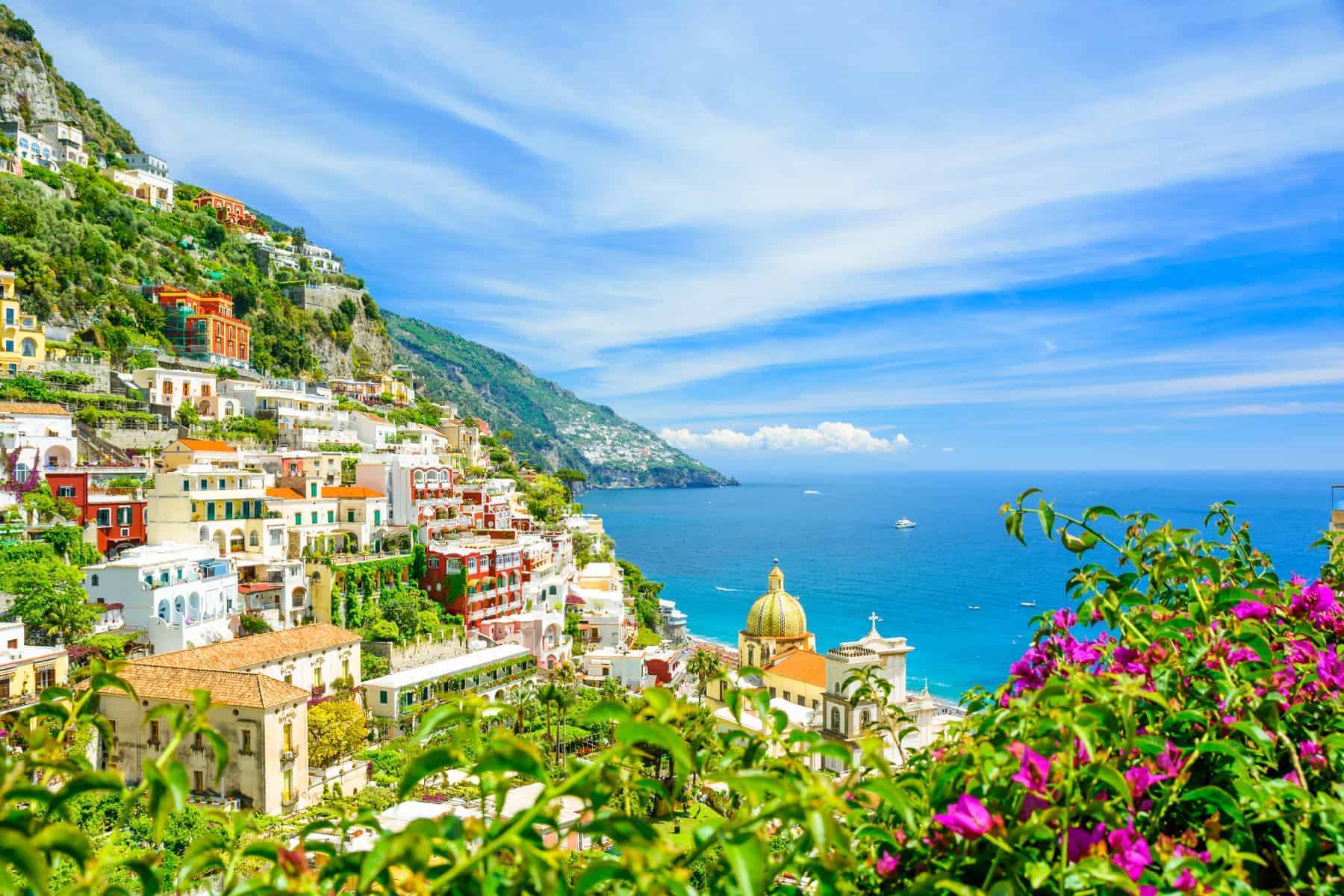
For classes conducted in English or other languages, you have an option of international or private schools.
In terms of educational quality, public schools in Italy are generally regarded as on par with, or even superior to, private schools.
Families with children have the following education options:
International Schools: These schools follow international curricula and often offer education in English or other foreign languages. Examples include the American Overseas School of Rome, the International School of Milan, and the British School of Milan.
Bilingual Schools: Some Italian schools offer bilingual programs, where students receive instruction in both Italian and another language. This can be a good option for your children to integrate into the local culture while maintaining their language skills.
Local Italian Public Schools: Local Italian public schools are free and accesible to all legal residents. They teach in Italian and can provide full immersion into the Italian language and culture. This option is typically best for younger children who can adapt to a new language environment more easily.
Religious Schools: Italy has various religious schools, including Catholic schools, which may be suitable for expat children from the same faith.
Travel and connectivity
Italy is exceptionally well-connected to the world through its international flight network. With numerous airports across the country, Italy is a major gateway for travelers from all corners of the globe.

Major international airports:
- Rome Fiumicino Airport (Leonardo da Vinci Airport): offers direct flights to a wide range of international destinations in Europe, North America, Asia, Africa, and the Middle East. It's a primary hub for international travelers to Italy.
- Milan Malpensa Airport: Malpensa is a key international airport, especially for travelers to and from northern Italy. It connects to many global cities, including New York, Tokyo, and Dubai.
- Venice Marco Polo Airport: Serving the Veneto region, Venice's airport offers flights to several international destinations, particularly across Europe.
Connectivity to North America
Italy maintains strong connections to North America, with direct flights to major cities such as New York, Miami, Los Angeles, and Toronto. These routes are popular among tourists, expatriates, and business travelers.
Asia and Middle East links
Italy is well-connected to Asian and Middle Eastern destinations, including major cities like Beijing, Shanghai, Dubai, and Tel Aviv.
International trains
- High-Speed Rail: Italy's high-speed rail network connects major cities like Milan, Rome, and Florence with neighboring countries such as France, Switzerland, and Austria. The Eurostar Italia and Thalys services provide efficient cross-border connections.
- EuroCity (EC) and EuroNight (EN) Trains: These international train services connect Italy with various European cities, including Vienna, Munich, Geneva, and more.
Ferries
Ferries and hydrofoils link Italy with Mediterranean destinations such as Greece, Croatia, Tunisia, and Spain.
Public transport
Major cities and northern regions are well-served with public transport.
However, getting around Italy's southern regions and islands without a car can be a challenge. Train services are limited, and buses can be uncomfortable as they navigate through traffic and potholed roads. Dealing with delays and unpredictable schedules can be frustrating.
Here are the main options when it comes to public transport
Planes:
- Milan, with its airports in Malpensa and Bergamo, offers numerous direct flights to southern Italy, Sicily, or Sardinia, with one-way fares available for as low as €10.
Trains:
- The main government-owned railway provider Trenitalia operates trains connecting cities such as Venice, Rome, Florence, Naples, Bologna, and Milan.
- Tren Italia's high-speed trains fall into three categories: FrecciaRosa, FrecciaArgento, and FrecciaBianca. These trains are slightly pricier and can sell out, so securing tickets in advance is advisable.
- For instance, the FrecciaRosa operates approximately seven times daily on the Venice-Milan route, completing the journey in around 2 hours. The average cost for this journey is approximately €50.
Buses:
- City Buses: In major cities like Rome, Milan, and Florence, a single ticket for city buses costs around €1.50-€2 and is often valid for 100 minutes.
- Inter-City Buses: The cost depends on the distance traveled. A one-way ticket for a longer inter-city bus journey can range from €20 to €50 or more.
- Flixbus covers some routes in regions like Tuscany, Puglia, and beyond, where trains are limited.
Trams and Metro:
- Prices for trams and metro are usually similar to city bus fares, typically around €1.50-€2 per single ticket.
- 24-hour ticket valid for unlimited metro, bus, and train travel within Rome costs €7.
Ferries and Water Taxis:
- In coastal cities and islands, ferry prices can vary significantly. For example, a ferry from Naples to Capri may cost around €20-€40 one way.
- Water taxis can be more expensive, with rates based on distance and location.
Taxis:
- Taxi fares are metered. A starting fee plus a per-kilometer charge applies. In major cities, the starting fee might be around €3-€6, with a rate of €1.30-€2 per kilometer.
- In Milan, for example, the basic fee is €3.70, and the kilometer price is €1.20 - €1.80. For standing and waiting time, €31.30 is charged per hour.
Car Rentals:
- Car rental prices vary by location and rental duration. Daily rental rates typically range from €50 to €100 or more, depending on the car type and rental agency.
Cycling:
- Many cities in Italy have bike-sharing programs, and the cost varies. Short-term rentals might cost around €2-€3 per hour.
- In Milan, for example, traditional bicycles are available for €1 per 20 minutes, while electric bikes (E-bikes) can be rented for €0.20 per minute. You can buy a monthly bike subscription for €9.99, valid for 30 days, or an annual subscription for €79.99.
Where to live in Italy
One of the best things about Italy is that it offers plenty of regional variations in lifestyle, climate, and scenery. Whether you fancy the Renaissance heritage of Florence or Venice, the bustle of Rome, or the island lifestyle of Sardinia or Capri, or the prestige of living in Milan, Italy has plenty to offer.
Here’s a roundup of some of the best choices for where to live in Italy.
Liguria
Located on the north-western coast, Liguria is quite a tourism-centred region. There’s a good reason for this - it’s got an amazing coastline, boasts beautiful weather, and stunning scenery.
If you don’t fancy dealing with too many tourists, moving away from the coast will result in a much quieter life surrounded by Italian families.
Rome
As you can imagine, Rome is a prime location for the real Italian experience. There’s plenty of cultural heritage and some of the best restaurants in the country.
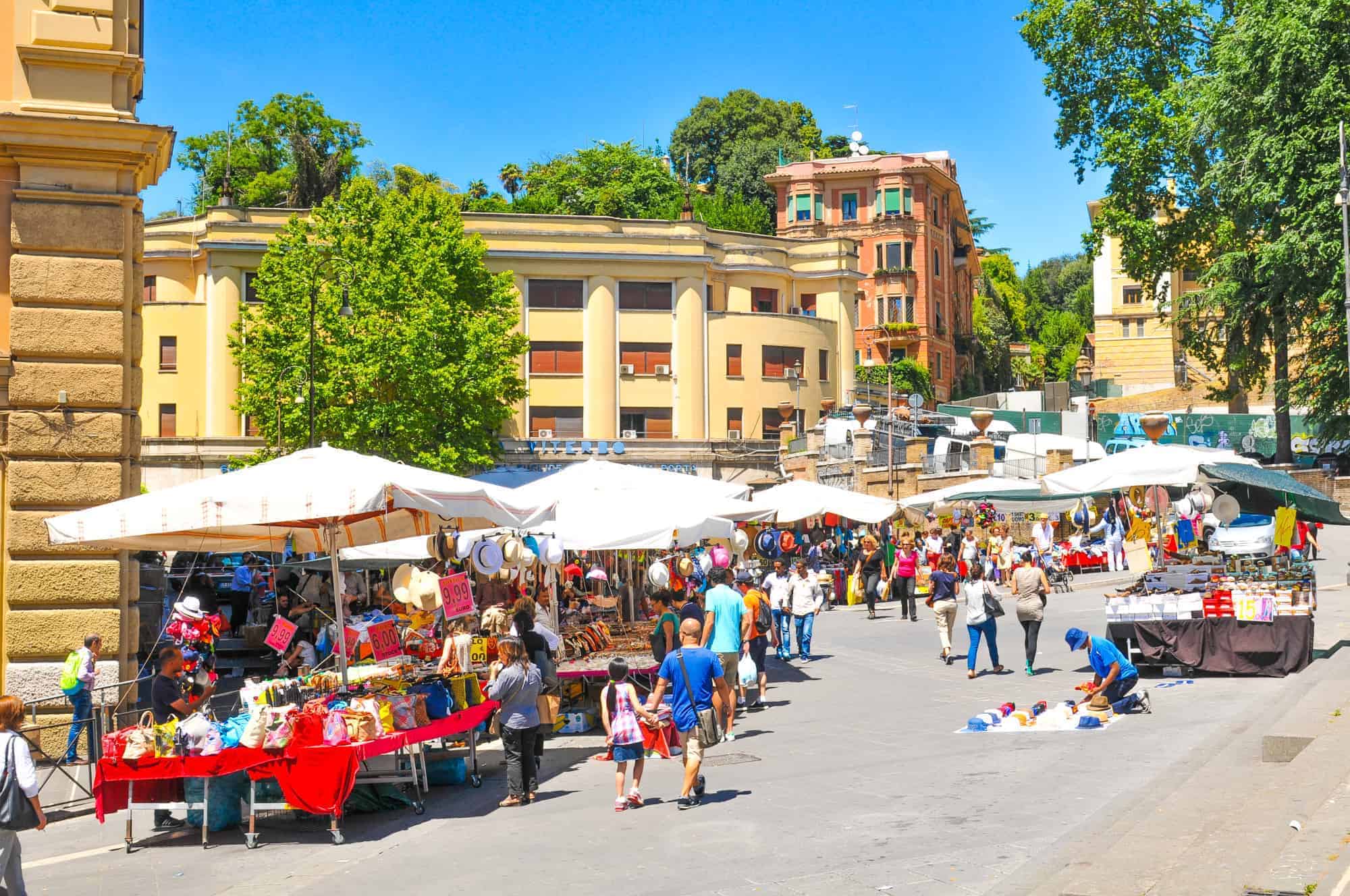
Tourism is a big deal here, and even in the off-season, it’s still a busy place. City living isn’t suitable for everyone, but if it appeals to you, then you should definitely move to Rome.
Siena
Located in Tuscany, central Siena has been designated a UNESCO World Heritage Site. It’s full of museums, art galleries, restaurants, and historic buildings, making it a great choice for those wanting culture.
If you don’t want to live in the city itself, consider moving to a smaller town like Montepulciano, San Gimignano, Buonconvento, or Pienza. All are less than 50 kilometers from the city and provide you with an intimate experience of living in Tuscany.
Naples
Naples is the third-largest city in Italy, located on the south-western coast. Its food offerings stand out, even among Italian cities, and you have historic sites like Pompeii, Herculaneum, and Vesuvius in easy reach.
It has an international airport and plenty of smaller satellite towns if you don’t want an inner-city home.
Parma
Parma is a central city located in the north of Italy. Famous, of course, for its ham, the city also boasts a deep cultural heritage and good connections to nearby historical centers.
For example, Florence is roughly 2 hours away by car. Parma has a great climate, exciting nightlife, and plenty to do all year round.
Find more information in our guide to The Best Places To Live In Italy For Expats - a detailed overview of the most popular expat destinations.
Other popular destinations in Italy to consider:
Buying property in Italy
If you’re buying property in Italy, you can do so without first being a permanent resident. In fact, you’ll need proof of address for your residency application.
You can use this property as your holiday home until then, provided you follow the travel guidelines.
Buying property in Italy isn’t a particularly complicated process, although it’s obviously made more difficult by the potential language barrier. It’s best to find someone who can translate to help make things easier.
You’ll first need to find an estate agent, all of whom must be registered with their local chamber of commerce. If you can find one who speaks English, even better.
Also, you’ll need a notary who closes the deal and seals the purchase contract. They also do all legal checks on the property.
In Itlay, the real estate agent works on behalf of both buyer and seller. They conduct price negotiations and provide the notary with documentation once the price has been agreed upon.
The notary requires various documents, but the only ones you’ll need to provide are your forms of ID; the seller gives everything else.
Once this has been organized and a survey completed, the notary draws up the preliminary agreement. This is a legally binding contract and requires you to pay a 10% deposit.
After this, the notary will write up the final deed, which must be signed in front of them. You then transfer funds to the seller, and the property is yours!
Banking and bank accounts in Italy
You can open a non-resident bank account in Italy, which you might need for purchasing property or accessing money abroad. Non-resident bank accounts only allow deposits in imported currency.
You can either do this at a branch of an Italian bank, or you can write a letter of authorization allowing someone (such as your estate agent) to open an account on your behalf.
Once you live in Italy, you’ll be able to open a bank account very easily, even before becoming a full resident. You’ll need documentation, such as your passport, proof of address, and residence card (if already a resident).
The typical documents needed to open a bank account in Italy include:
- Identification: A valid passport or identity card as proof of your identity.
- Tax Identification Number (Codice Fiscale): An Italian tax identification number that can be obtained from the local tax office.
- Residence Permit: If you are a non-EU citizen, you may need to provide a valid residence permit.
- Proof of Address: A utility bill, rental agreement, or other official document to confirm your residential address in Italy.
- Proof of Income: Depending on the bank and the type of account you want to open, you may need to provide proof of income, such as pay stubs, an employment contract, or proof of pension or other income sources.
- Bank-Specific Forms: The bank may require you to fill out specific forms provided by the institution.
- Initial Deposit: Some banks may require an initial deposit to open the account, while others offer no-deposit accounts.
- Letter of Introduction: In some cases, a reference or letter of introduction from another bank may be requested, especially for international clients.
Non-EU driving licences
In most cases, for a short period of time, you can drive in Italy using your home country's driving license, together with an International Driving Permit (IDP).
The IDP is a recognized document for driving in many European and some non-European nations that provides foreign authorities with the exact interpretation of the driving license in the holder’s possession.
Once you become a resident of Italy, you’ll need to exchange your license for an Italian one.
Converting a foreign driving license to an Italian one without taking an Italian driving test can be possible depending on whether there are reciprocity agreements in place between Italy and your home country.
The UK has such an agreement, while, unfortunately, the USA and Canada do not.
In many cases, non-EU citizens need to take an Italian driving test to obtain their license. The process also requires you to obtain a new picture and have the license registered to your Italian address.
If you take your car to Italy, you’ll need to get it registered with Italian plates within 60 days of becoming a resident. Not doing so will result in your car being impounded.
Bringing your pets to Italy
Before you begin the process, it's essential to understand Italy's pet entry requirements. Check the Italian Ministry of Health's website or contact the Italian embassy or consulate in your country for up-to-date information. These requirements may vary based on your pet's species and country of origin.
Step 1: Microchipping your pet
Ensure your pet is microchipped with an ISO 11784/11785-compliant 15-digit pet microchip. This is crucial for identification and must be done before any vaccinations.
Step 2: Vaccination requirements
- Rabies vaccination: Your pet must be vaccinated against rabies, typically at least 21 days before entering Italy. Ensure the vaccination is up-to-date and administered by a licensed veterinarian. Keep a copy of the vaccination certificate.
- Additional vaccinations: Other vaccinations may be necessary depending on your pet's species and specific health requirements. Consult with your veterinarian for guidance.
Step 3: Pet health certificate
Obtain an EU Pet Passport if your pet is an EU citizen or an International Health Certificate if not. The certificate should include:
- Pet's identification information (microchip or tattoo).
- Rabies vaccination details.
- Description of your pet's physical condition.
Step 4: Tick and tapeworm treatment
For dogs, tick and tapeworm treatment is usually required within 24-120 hours before entry. Make sure your veterinarian administers this treatment and records it in your pet's health certificate.
Step 5: Plan your travel
Choose a reputable airline or pet transport service to help you plan your pet's travel. Ensure they are aware of the specific requirements for transporting pets to Italy. Book your pet's flight well in advance.
Step 6: Import procedures
- Customs declaration: When you arrive in Italy, declare your pet to customs officials.
- Border inspection: Expect an inspection of your pet and its documentation at the point of entry in Italy.
Tip: Some pet transport companies can help you organize the whole process from the information on the necessary documentation to transportation and border inspection.
Step 7: Register with a local veterinarian
Once in Italy, register your pet with a local veterinarian. They can assist with post-arrival requirements, including any further vaccinations or health checks.
Getting connected in Italy
Currently, three major companies dominate the mobile phone market in Italy: Wind Tre, Vodafone, and Telecom Italia.
It’s possible to get your mobile and internet services from the same company, which might be the easiest option when you first move there.
To register, you’ll need proof of ID (passport, for example) and proof of address. It’s easiest to register in person at a store, and if you go to a larger town or city, the staff will likely speak English.
Internet quality in Italy
It is no surprise that internet connection speeds can vary across the country. Italy was one of the first European nations to adopt the internet, but it’s potentially not progressed past this early stage in some areas.
Towns and cities will offer reasonably good broadband while smaller towns and villages, particularly in rural areas, are still on dial-up and ADSL.
Some parts of southern Italy may lag behind in terms of infrastructure development. Some of Italy's islands, like Sicily and Sardinia, may have more limited internet access compared to the mainland.
If good internet is essential, use Telecom Italia’s speed connection test. The company is the largest internet provider in the country.
Language barrier
English is more widely spoken in larger cities, but more rural areas rely pretty much entirely on Italian. German is spoken in some northern areas, so bear this in mind if you already speak it.
Some regions where you might find more English speakers include:
- Rome: The capital city attracts a lot of tourists, and many people working in the tourism industry can communicate in English.
- Florence: Another popular tourist destination with English-speaking locals in the tourism sector.
- Venice: As a top tourist city, you can find English speakers here.
- Milan: Italy's financial and business hub often has a higher percentage of English speakers.
- Amalfi Coast: This beautiful coastal area is a popular destination for international tourists, and English is commonly used.
- Sicily: In tourist-heavy areas of Sicily, you may find people who speak English.
- Sardinia: Popular with tourists, some English is spoken in the tourist areas.
However, the moment you step out of a tourist bubble, you need to speak at least some Italian to get by. It's always a good idea to have some basic knowledge of Italian or use translation tools when traveling in areas where English is less commonly spoken.
Final thoughts on living in Italy
As you can see, living in Italy offers a lot of positives for anyone wanting a cultured yet relaxed lifestyle. The country offers a blend of history and modernity, excellent healthcare, and easy access to the rest of Europe, making it an attractive destination for expatriates seeking a unique experience.
You might find helpful:
- The Best Places To Live In Italy For Expats
- The Guide to EU Golden Visas - the fast track way to get full EU residence
- The Expat Guide To UK Pensions Abroad: Understand Your Options
- Didn’t find what you were looking for or need further advice? Comment with your question below and we will do our best to help.
Helpful external links:
- How to voluntarily register with the SSN - salute.gov.it
- Information for British citizens moving to or living in Italy - gov.uk.
- USA embassies and consulates in Italy - it.usembassy.gov.
Secure Peace of Mind with Best-Value International Health Coverage
International Citizens Insurance provide free, no-obligation quotes from the leading international health insurance providers with plans tailored to meet your needs. Trusted by thousands of expats worldwide.











